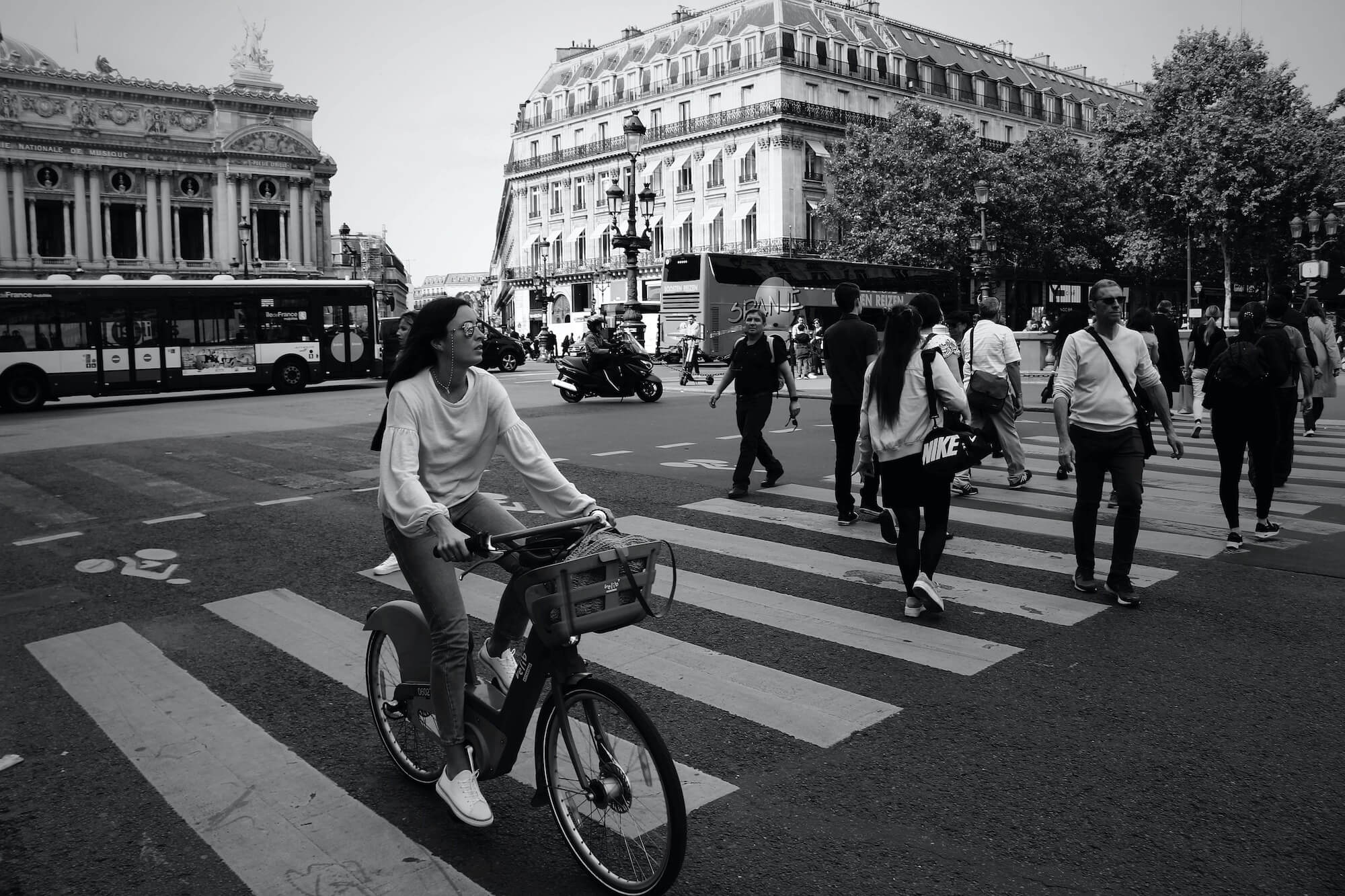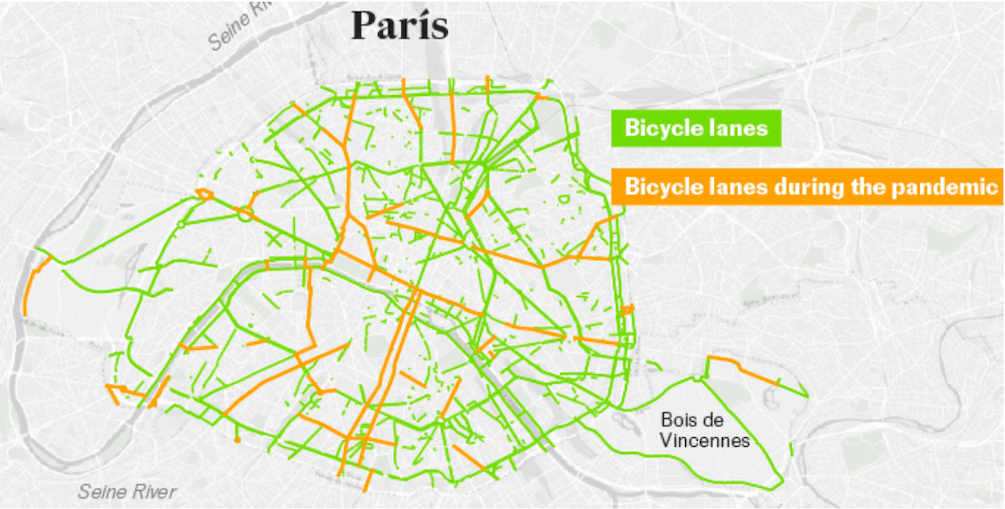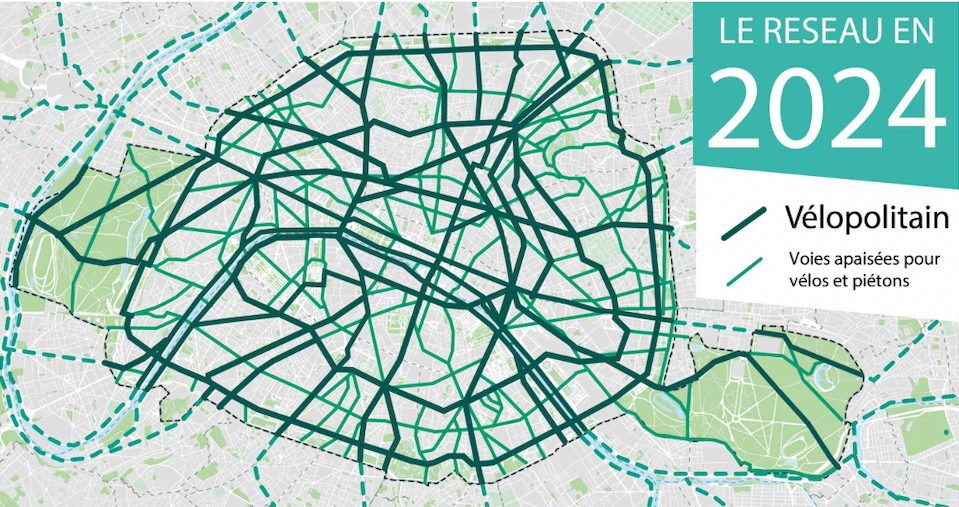In cooperation with our project partner Toyota Kreditbank we assessed new mobility concepts in European cities. The article shares the findings and learnings from the 15-Minute City.
The idea of the “la ville du quart d’heure” is based on how the time of city dwellers could be transformed to improve their living conditions and the environment. Professor Carlos Moreno at the Sorbonne University in Paris dedicated the concept to the accessibility of daily urban necessities within a 15-minute radius by foot or bicycle. In the same timespan, commuters may have waited for a train or a bus they will reach destinations like work, education, shops, entertainment and healthcare.
Gemeinsam mit unserem Projektpartner der Toyota Kreditbank haben wir neue Mobilitätskonzepte in europäischen Städten untersucht. In diesem Artikel möchten wir unsere Erkenntnisse und Lehren aus der 15-Minuten Stadt teilen.
Die Idee «la ville du quart d’heure» basiert auf der Erforschung, wie die Zeitnutzung der Stadtbewohner neu organisiert werden kann, um sowohl die Lebensbedingungen als auch die Umwelt zu verbessern. Professor Carlos Moreno von der Pariser Sorbonne Universität versteht darunter, dass die täglichen Bedürfnisse in einem Umkreis von nicht mehr als 15 Minuten zu Fuß oder per Rad erreicht werden können. In der gleichen Zeitspanne, in der Pendler auf einen Zug oder Bus gewartet haben, werden sie in Zukunft Ziele wie Arbeit, Geschäfte, Kinos, medizinische Versorgungs- und Bildungseinrichtungen erreichen.
The implementation of the 15-Minute City idea stems from the Paris Climate action plan and is the flagship of Mayor Anne Hidalgo’s re-election campaign in 2020, addressing climate change challenges with the revival of Paris’s neighbourhoods. Through the plan’s implementation, various policies have been adopted to reduce car dominance, regaining space from cars, increasing the tree canopy, and enhancing pedestrian mobility [1].
In a 15-Minute City, citizen needs are able to be reached within a short walk or bike ride from home. Therefore, amenities like healthcare facilities, preschools and schools, social services, commercial services, leisure, cultural and entertainment amenities, parks and natural areas will be established in the neighbourhoods. Figure 1 shows the intention of the model to reconnecting people to their neighbourhoods and localise city life. [2, p. 3-4]

Figure 1: The 15-Minute City concept [3]
Supporting Pillars of the 15-Minute City
- Paris will open its dens public-school network to the neighbourhoods and make them into small city centres for the surrounding community. School courtyards will be transformed into green spaces that neighbourhood residents can benefit from, and they will be accessible on weekends and evenings. In addition, the streets next to the educational institutions will have limited or no traffic [4].
- The 15-Minute City will decentralise the city on structural and administrative levels. A decentralisation offers the benefits of having a public representative in the resident’s district.
- Equally crucial to the concept are local urban services and workplaces, as the journey to the workplace is the most inflexible trip on weekdays [2, p. 4].
- The main difference to other neighbourhood centred approaches is the intention to bring activities to the neighbourhoods and not people to the activities. Therefore, the community in the neighbourhood is built through equal access to opportunities as well as facilities, engaging in local communities and local social interaction. Moreover, the stability of the community, pride of the local neighbourhood, sense of belonging and feeling safe is strengthened by affordable housing, inclusive, barrier-free and affordable mobility, and equal opportunities to employment and education [2, p. 4].
Hence, the participation of the residents from designing the vision of the neighbourhood to the selection and implementation of local projects is essential to the success of the 15-Minute City. The process must involve low-income and disadvantaged community members as well as local companies. As a result, the 15-minute radius has its fundament in the neighbourhood and is established by its residents.
Cycling and walking at the centre of the mobility concept
The high urban density, which supports the walkability and access to different facilities along with the well-developed transit system, supports the city of Paris to bring activities to the neighbourhoods. Thus, walking is prioritised in large parts of the city and matched with alternative active mobility options. [2, p. 18]
Paris will invest 300 million euros to create bike lanes and to improve existing pedestrian and bike routes. The investment aims to change the mobility patterns of the residents in the long run by replacing 60.000 parking slots with bike lanes until 2024. [2, p. 18] Figure 2 (right) shows the planned development of bike lanes in Paris until 2024. The dark green bold lines illustrate the fast lanes for bicycles, and the light green routes display traffic-calmed walking and cycling streets. [5]

Figure 2: Development of bicycle lanes amid COVID-19 (left) [6] and until 2024 (right) [5]
Finally, the city installed “corona cycleways” due to COVID-19, illustrated in Figure 2 (left), to decrease crowding in public transportation and discourage car usage for commuting purposes. Consequently, 50 kilometres of temporary bike lanes were built in Paris by using the car infrastructure. [6, 7] The inaccessibility of cars in the neighbourhoods with exceptions to residents, shopkeepers, public transport and taxis is also part of the 15-Minute City. In addition, “Children’s roads” will be established next to schools and traffic will be banned during school opening and closing times.
Paris focuses on the accessibility of urban necessities and puts, instead of the travel speed, the needs of its residents first. Services and jobs will be closer to home, which will lead to traffic avoidance. Access is the mobility concept we need.
Contact
Michael Semmer, michael.semmer@unisg.ch
References
[1] N. Whittle, “Welcome to the 15-minute city,” Financial Times, 17 Jul., 2020. https://www.ft.com/content/c1a53744-90d5-4560-9e3f-17ce06aba69a (accessed: Jun. 28 2021).
[2] G. Pozoukidou and Z. Chatziyiannaki, “15-Minute City: Decomposing the New Urban Planning Eutopia,” Sustainability, vol. 13, no. 2, 2021, doi: 10.3390/su13020928.
[3] H. Arnarsdóttir, Paris Will Provide Citizens Everything They Need Within a 15-Minute Radius. [Online]. Available: https://popupcity.net/observations/paris-will-provide-citizens-everything-they-need-within-a-15-minute-radius/ (accessed: Feb. 25 2021).
[4] Eurocities, Parisians will live within a 15-minute radius. [Online]. Available: https://eurocities.eu/latest/parisians-will-live-within-a-15-minute-radius/ (accessed: Feb. 25 2021).
[5] J.-L. Missika, Ecologie – Anne Hidalgo 2020. [Online]. Available: https://annehidalgo2020.com/thematique/test-thematique-2/ (accessed: Feb. 26 2021).
[6] M. Á. Medina, C. ÁLvarez, Y. Clemente, and M. Zafra, “Bike lanes: How cities across the world are responding to the pandemic,” El Pais, 06 Nov., 2020. https://english.elpais.com/society/2020-11-06/bike-lanes-how-cities-across-the-world-are-responding-to-the-pandemic.html (accessed: Feb. 25 2021).
[7] Schweizer Radio und Fernsehen (SRF), Autos, Stau und schlechte Luft – Velo wird zum Wahlkampfthema in Paris. [Online]. Available: https://www.srf.ch/news/international/autos-stau-und-schlechte-luft-velo-wird-zum-wahlkampfthema-in-paris# (accessed: Feb. 27 2021).
In cooperation with our project partner Toyota Kreditbank we assessed new mobility concepts in European cities. The article shares the findings and learnings from the 15-Minute City.
The idea of the “la ville du quart d’heure” is based on how the time of city dwellers could be transformed to improve their living conditions and the environment. Professor Carlos Moreno at the Sorbonne University in Paris dedicated the concept to the accessibility of daily urban necessities within a 15-minute radius by foot or bicycle. In the same timespan, commuters may have waited for a train or a bus they will reach destinations like work, education, shops, entertainment and healthcare.
Gemeinsam mit unserem Projektpartner der Toyota Kreditbank haben wir neue Mobilitätskonzepte in europäischen Städten untersucht. In diesem Artikel möchten wir unsere Erkenntnisse und Lehren aus der 15-Minuten Stadt teilen.
Die Idee «la ville du quart d’heure» basiert auf der Erforschung, wie die Zeitnutzung der Stadtbewohner neu organisiert werden kann, um sowohl die Lebensbedingungen als auch die Umwelt zu verbessern. Professor Carlos Moreno von der Pariser Sorbonne Universität versteht darunter, dass die täglichen Bedürfnisse in einem Umkreis von nicht mehr als 15 Minuten zu Fuß oder per Rad erreicht werden können. In der gleichen Zeitspanne, in der Pendler auf einen Zug oder Bus gewartet haben, werden sie in Zukunft Ziele wie Arbeit, Geschäfte, Kinos, medizinische Versorgungs- und Bildungseinrichtungen erreichen.
The implementation of the 15-Minute City idea stems from the Paris Climate action plan and is the flagship of Mayor Anne Hidalgo’s re-election campaign in 2020, addressing climate change challenges with the revival of Paris’s neighbourhoods. Through the plan’s implementation, various policies have been adopted to reduce car dominance, regaining space from cars, increasing the tree canopy, and enhancing pedestrian mobility [1].
In a 15-Minute City, citizen needs are able to be reached within a short walk or bike ride from home. Therefore, amenities like healthcare facilities, preschools and schools, social services, commercial services, leisure, cultural and entertainment amenities, parks and natural areas will be established in the neighbourhoods. Figure 1 shows the intention of the model to reconnecting people to their neighbourhoods and localise city life. [2, p. 3-4]

Figure 1: The 15-Minute City concept [3]
Supporting Pillars of the 15-Minute City
- Paris will open its dens public-school network to the neighbourhoods and make them into small city centres for the surrounding community. School courtyards will be transformed into green spaces that neighbourhood residents can benefit from, and they will be accessible on weekends and evenings. In addition, the streets next to the educational institutions will have limited or no traffic [4].
- The 15-Minute City will decentralise the city on structural and administrative levels. A decentralisation offers the benefits of having a public representative in the resident’s district.
- Equally crucial to the concept are local urban services and workplaces, as the journey to the workplace is the most inflexible trip on weekdays [2, p. 4].
- The main difference to other neighbourhood centred approaches is the intention to bring activities to the neighbourhoods and not people to the activities. Therefore, the community in the neighbourhood is built through equal access to opportunities as well as facilities, engaging in local communities and local social interaction. Moreover, the stability of the community, pride of the local neighbourhood, sense of belonging and feeling safe is strengthened by affordable housing, inclusive, barrier-free and affordable mobility, and equal opportunities to employment and education [2, p. 4].
Hence, the participation of the residents from designing the vision of the neighbourhood to the selection and implementation of local projects is essential to the success of the 15-Minute City. The process must involve low-income and disadvantaged community members as well as local companies. As a result, the 15-minute radius has its fundament in the neighbourhood and is established by its residents.
Cycling and walking at the centre of the mobility concept
The high urban density, which supports the walkability and access to different facilities along with the well-developed transit system, supports the city of Paris to bring activities to the neighbourhoods. Thus, walking is prioritised in large parts of the city and matched with alternative active mobility options. [2, p. 18]
Paris will invest 300 million euros to create bike lanes and to improve existing pedestrian and bike routes. The investment aims to change the mobility patterns of the residents in the long run by replacing 60.000 parking slots with bike lanes until 2024. [2, p. 18] Figure 2 (right) shows the planned development of bike lanes in Paris until 2024. The dark green bold lines illustrate the fast lanes for bicycles, and the light green routes display traffic-calmed walking and cycling streets. [5]

Figure 2: Development of bicycle lanes amid COVID-19 (left) [6] and until 2024 (right) [5]
Finally, the city installed “corona cycleways” due to COVID-19, illustrated in Figure 2 (left), to decrease crowding in public transportation and discourage car usage for commuting purposes. Consequently, 50 kilometres of temporary bike lanes were built in Paris by using the car infrastructure. [6, 7] The inaccessibility of cars in the neighbourhoods with exceptions to residents, shopkeepers, public transport and taxis is also part of the 15-Minute City. In addition, “Children’s roads” will be established next to schools and traffic will be banned during school opening and closing times.
Paris focuses on the accessibility of urban necessities and puts, instead of the travel speed, the needs of its residents first. Services and jobs will be closer to home, which will lead to traffic avoidance. Access is the mobility concept we need.
Contact
Michael Semmer, michael.semmer@unisg.ch
References
[1] N. Whittle, “Welcome to the 15-minute city,” Financial Times, 17 Jul., 2020. https://www.ft.com/content/c1a53744-90d5-4560-9e3f-17ce06aba69a (accessed: Jun. 28 2021).
[2] G. Pozoukidou and Z. Chatziyiannaki, “15-Minute City: Decomposing the New Urban Planning Eutopia,” Sustainability, vol. 13, no. 2, 2021, doi: 10.3390/su13020928.
[3] H. Arnarsdóttir, Paris Will Provide Citizens Everything They Need Within a 15-Minute Radius. [Online]. Available: https://popupcity.net/observations/paris-will-provide-citizens-everything-they-need-within-a-15-minute-radius/ (accessed: Feb. 25 2021).
[4] Eurocities, Parisians will live within a 15-minute radius. [Online]. Available: https://eurocities.eu/latest/parisians-will-live-within-a-15-minute-radius/ (accessed: Feb. 25 2021).
[5] J.-L. Missika, Ecologie – Anne Hidalgo 2020. [Online]. Available: https://annehidalgo2020.com/thematique/test-thematique-2/ (accessed: Feb. 26 2021).
[6] M. Á. Medina, C. ÁLvarez, Y. Clemente, and M. Zafra, “Bike lanes: How cities across the world are responding to the pandemic,” El Pais, 06 Nov., 2020. https://english.elpais.com/society/2020-11-06/bike-lanes-how-cities-across-the-world-are-responding-to-the-pandemic.html (accessed: Feb. 25 2021).
[7] Schweizer Radio und Fernsehen (SRF), Autos, Stau und schlechte Luft – Velo wird zum Wahlkampfthema in Paris. [Online]. Available: https://www.srf.ch/news/international/autos-stau-und-schlechte-luft-velo-wird-zum-wahlkampfthema-in-paris# (accessed: Feb. 27 2021).



